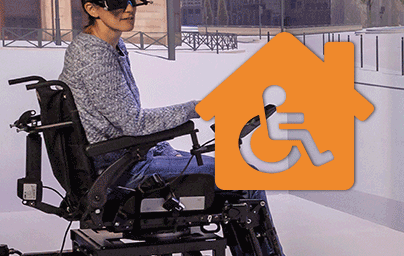

Digital for inclusiveness and home support
For some elderly or handicapped people, the absence or loss of mobility, the limitation of exploration capacities, deprives them of autonomy and independence in daily or social activities. Although solutions exist in terms of support or technical aids, the prevention and preservation of independence, inclusiveness and home support has become a national public health priority.
To meet this priority, the design of technological tools is part of the panel of possible solutions. Marie Babel, INSA teacher-researcher and member of the Rainbow research team, is working on robotics for assisting people, in order to create mobility aid devices for people with disabilities. Solutions to assist the movement of an electric wheelchair with adapted correction of the trajectory of the chair have been developed by Marie and her team, and tested on patients thanks to close collaboration with the physical medicine and rehabilitation center of the Pôle Saint Hélier.
For 10 years now, Marie has been piloting many collaborative projects, related to the autonomy and independence of people with disabilities, under different scientific axes (Robotics, Computer Science, Electronics, Mechanics, Biomechanics, Virtual Reality) with a strong multidisciplinary approach.
Launch of the Innovations, Handicap, Autonomy and Accessibility Chair (IH2A)
To perpetuate these activities, the Innovations, Handicap, Autonomy and Accessibility (IH2A) chair, held by Marie Babel, was inaugurated in September 2020.
Placed under the aegis of the Fondation INSA, the chair draws on the recognized expertise of the IRISA, IETR, LGCGM and M2S laboratories to conduct large-scale research in the service of people with disabilities. The design of systems must on the one hand compensate for motor, sensory and cognitive deficiencies, while at the same time enriching the sensations perceived by users of these new technologies. But we can also see another objective in learning how to use these systems, which is of the order of rehabilitation and to allow accessibility in the broadest sense to social activities (accessibility of places, culture, heritage ....).
A dedicated and collaborative space - the Maison Innovations et Handicap (MIH) - will be created in 2021. This experimentation space will be used to test and evaluate clinical trials and the benefits of using these digital and health technologies. Reproductions of everyday life or leisure situations (navigation in electric wheelchairs, adapted sports, visits to heritage sites, etc.) will make it possible to assess the scientific interest and performance of the targeted technologies (robustness, energy consumption, etc.) but also to measure the fidelity of multi-sensory simulators, the safety of assistance solutions, the accessibility of public facilities, etc.
Rennes, a reference center in the field of innovation for the autonomy and accessibility of people with disabilities
And finally, this chair wishes to participate in strengthening the ecosystem of Rennes and Brittany in the field of innovation for the autonomy and accessibility of people with disabilities and thus make Rennes a center of reference.
Both in connection with the S3 (intelligent specialization strategy for research and innovation) of the Brittany Region (Glaz Economie), the Chair is located at the crossroads of several of the Breton Strategic Innovation Domains: "Technologies for the digital society" and "Health and well-being for a better quality of life", where disability clearly appears as a societal and economic issue.
Initial contacts have been established with the Museum of Brittany in order to broaden the field of applications of assistive and exploration technologies to the discovery of the Breton heritage. Collaboration could strengthen the museum inclusiveness approach undertaken by the Musée de Bretagne and Les Champs Libres.
In addition, as part of the European ADAPT project, Rennes Métropole has made available 3D models of part of the city of Rennes. The projected use is clear: to test the development and check the accessibility of the premises and, on the other hand, to raise awareness among planners and architects of the problem of reduced mobility. This first fruitful experience makes it possible to envisage the deployment of these technologies to all the players in the construction of the inclusive city.
